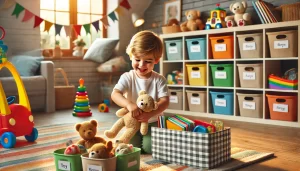Creating an emotionally safe environment at home is essential for a child’s well-being and development. When children feel emotionally secure, they are more likely to express their feelings, develop self-confidence, and build strong relationships. Emotional safety provides the foundation for healthy communication, emotional regulation, and personal growth.
In this article, we’ll explore the importance of emotional safety, how to recognize an emotionally secure environment, and practical strategies to create a nurturing space where children feel safe, valued, and understood.
Why Is Emotional Safety Important for Children?
An emotionally safe environment helps children:
- Develop self-confidence – When children feel accepted, they trust themselves and their abilities.
- Express emotions freely – A safe space allows them to communicate feelings without fear of judgment.
- Build resilience – Knowing they are supported helps children handle challenges and setbacks.
- Form secure relationships – Emotional safety strengthens bonds with parents, caregivers, and friends.
- Improve learning and creativity – A stress-free environment encourages curiosity and exploration.
By fostering emotional safety, parents help children grow into emotionally healthy and confident individuals.
How to Recognize an Emotionally Safe Environment
An emotionally safe home is characterized by:
✅ Open communication – Children feel comfortable sharing their thoughts and emotions.
✅ Consistent love and support – They know they are valued, even when they make mistakes.
✅ Respect for emotions – Their feelings are acknowledged and validated.
✅ Healthy conflict resolution – Disagreements are handled with patience and understanding.
✅ Encouragement rather than criticism – Mistakes are seen as learning opportunities.
If a child hesitates to express emotions, fears punishment for mistakes, or avoids conversations about feelings, it may indicate a need for a safer emotional environment.
Strategies to Create an Emotionally Safe Environment
Encourage Open and Honest Communication
Children should feel safe discussing their thoughts and feelings without fear of punishment or dismissal. Encourage communication by:
- Asking open-ended questions – “How was your day?” instead of “Did you have a good day?”
- Listening without interrupting – Give them time to express their emotions fully.
- Responding with empathy – “I understand why you feel that way” instead of “You shouldn’t feel like that.”
When children know their words matter, they are more likely to express themselves.
Validate Their Feelings
Acknowledging emotions helps children feel understood. Instead of dismissing their feelings, try:
❌ “Stop crying, it’s not a big deal.”
✅ “I see that you’re upset. Do you want to talk about it?”
Even if their feelings seem small to you, they are big to them. Validating emotions teaches children that their feelings are important.
Use Positive and Supportive Language
The way we speak to children affects their self-esteem. Instead of criticism, focus on encouragement:
❌ “You never listen!”
✅ “I need you to focus a little more next time.”
❌ “That’s wrong!”
✅ “Let’s try it a different way.”
Supportive language builds confidence and emotional security.
Set Clear and Consistent Boundaries
Children feel safer when they understand rules and expectations. Establish clear boundaries, such as:
- Respecting personal space.
- Using kind words when expressing frustration.
- Following routines for meals, bedtime, and screen time.
Consistency helps children feel secure, knowing what to expect.
Create a Safe Space for Emotional Expression
Having a designated “calm-down corner” or a cozy spot with soft pillows, books, and stress-relief toys allows children to regulate their emotions when they feel overwhelmed. Encourage them to:
- Take deep breaths.
- Hug a stuffed animal.
- Write or draw their feelings.
This teaches children healthy coping mechanisms.
Teach and Model Healthy Conflict Resolution
Disagreements are a natural part of life. Teach children how to resolve conflicts peacefully:
- Encourage “I” statements: “I feel sad when you take my toy without asking.”
- Teach taking turns speaking and listening to the other person’s point of view.
- Model calm discussions instead of shouting or blaming.
When children see healthy conflict resolution, they learn how to handle disagreements positively.
Offer Unconditional Love and Support
Children should feel loved regardless of their mistakes or challenges. Remind them:
- “I love you no matter what.”
- “It’s okay to make mistakes; we learn from them.”
- “I’m here to help you when things are hard.”
Knowing they are supported builds emotional security.
Encourage Emotional Intelligence Through Play
Play helps children understand and express emotions. Some great activities include:
- Emotion charades – Act out different emotions and guess them.
- Storytelling about feelings – Read books that explore emotions.
- Drawing emotions – Have children draw how they feel.
These activities make learning about emotions fun and engaging.
Reduce Stress and Pressure
Children should feel safe to be themselves without excessive pressure. Avoid:
- Comparing them to siblings or friends.
- Expecting perfection.
- Overloading them with activities.
Instead, focus on progress and effort rather than results.
Make Time for One-on-One Connection
Spending quality time together strengthens emotional bonds. Simple activities like:
- Reading a book together.
- Going for a walk.
- Having a “talk time” before bed.
These moments reinforce emotional safety and make children feel valued.
Fun Activities to Strengthen Emotional Safety at Home
“Feelings Journal”
Encourage children to write or draw their emotions in a journal. This helps them process feelings in a private and safe way.
“Three Good Things” Activity
Each day, ask your child to name three good things that happened. This promotes gratitude and positive thinking.
“Safe Space Pledge”
Create a family agreement that outlines how everyone will support emotional safety, such as:
- “We listen to each other without interrupting.”
- “We respect each other’s feelings.”
- “We use kind words even when we disagree.”
Display it in a shared space as a daily reminder.
“Worry Box”
Have a small box where children can write down worries and place them inside. At the end of the week, discuss any concerns together to show that their feelings matter.
“Emotion Matching Game”
Use emotion flashcards with different facial expressions and match them to real-life scenarios. For example:
- “When do you feel excited like this?”
- “What makes you feel sad like this?”
This helps children identify and express emotions.
When to Seek Additional Support
While most children thrive in a nurturing home, some may need extra support. Consider seeking guidance from a child psychologist if:
- Your child frequently withdraws or avoids expressing emotions.
- They have extreme reactions to small frustrations.
- They show persistent fear or anxiety about speaking up.
A professional can provide personalized strategies to enhance emotional well-being.
Final Thoughts
An emotionally safe environment allows children to grow with confidence, express their emotions freely, and develop strong relationships. By practicing open communication, modeling healthy emotional responses, and creating a nurturing space, parents and caregivers can provide children with the security they need to thrive.
With patience and consistency, you can help your child feel valued, understood, and emotionally supported, setting the foundation for lifelong well-being.




